 College Week Bonny Baby Competition, 1974
College Week Bonny Baby Competition, 1974 Dolores Monaghan (BA 1976, H.Dip Education 1977) is the 'mother' wheeling Pat Hoade (BSc 1976, PhD 1982) in Eyre Square where the competition was held.
Pat Hoade, later Pat Morgan, held appointments in Biochemistry and as Dean of Graduate Studies, Dean of the College of Science and Vice-President for the Student Experience, in the University of Galway.
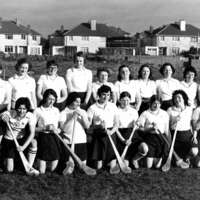 Camogie team, 1976
Camogie team, 1976 Photograph of the UCG team in Pearse Stadium, taken in 1976.
Front row: the first person is Kathleen Delaney who probably graduated in Medicine in 1978. The remaining members of the team have not been identified.
The stadium was officially opened on 16 June 1957. Following a period of disuse in the 1990s, renovations were undertaken in 2002 and the stadium reopened in 2003.
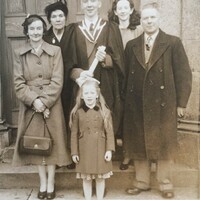 Graduation of Tony Bromell in 1954
Graduation of Tony Bromell in 1954 The image is of Tony Bromell from Limerick, who graduated with a BA in 1954, with his parents and other family members on the steps to the entrance to the Aula Maxima in the Quadrangle, UCG. Tony was the first person from his family to graduate from university, and his entire family travelled to Galway for the ceremony in a taxi that was hired for the purpose.
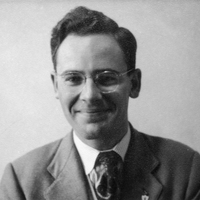 Dr. Diarmuid Ó Cearbhaill as an undergraduate at UCG
Dr. Diarmuid Ó Cearbhaill as an undergraduate at UCG The subject is depicted in portrait format, and is formally dressed in a jacket and tie, and wearing glasses. His pioneer pin is in evidence on the lapel of his jacket.
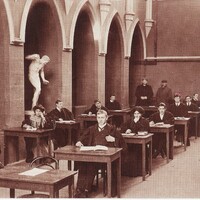 Examination candidates in the Aula Maxima, 1909
Examination candidates in the Aula Maxima, 1909 A picture of examination candidates in the Aula Maxima in 1909 is shown here, which includes partial images of three other candidates. Two persons in the backgound may be examination supervisors, one of whom looks like a priest – possibly Revd T.R. Mac Alinney, the Catholic Dean of Residence at the time. Two Roman style sculptures mounted on pedestals between Aula Maxima arches can also be seen.
Two marble Greek sculptures mounted on pedestals between Aula Maxima arches can also be seen. The one on the left is the Discobolus (‘discus thrower’) by Myron and is a cast of the 2nd century AD Roman marble copy of the bronze Greek original completed at around 460-450 BC – which was lost. The sculpture depicts a youthful male athlete about to release his throw of the discus. The sculpture is probably a cast of the so-called Townley Discobulus (Wikipedia /Discobolus, Sept. 2023), discovered at Hadrians’ Villas in 1791, restored (incorrectly retored with head in an incorrect orientation) and purchased by Charles Townley for £400, and bought by the British Museum in 1805 (www.britishmuseum). There is no information on the second marble sculpture, which appears to show an athlete holding rings in both hands.Extracts from minutes of the College Council in 1855 (Minutes of the College Council) reports on invoice of casts presented to the College, with a reference to the casts being located in the Museum rather than in the Aula Maxima at that time.
This picture, which is held in the University of Galway Library’s archive, appeared in a postcard which was for sale in the Student’s Union Shop.
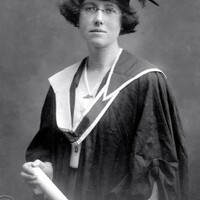 Rita Carlos Graduation in 1922
Rita Carlos Graduation in 1922 Margaret (Rita) Carlos entered UCG in 1919 and graduated with a 1st Class Honours BA degree in 1922, followed by a Higher Diploma in Education in 1923. She married Patt Larkin on 3rd September 1926 and had nine children. Rita Carlos Larkin died on 1st April 1987.
Margaret (Rita) Carlos was born in Woodquay, Galway on 7 Sept. 1900 to Charles Carlos and Charlotte Shortle. She was the eldest of six children, two of whom were lost in the Spanish Flu epidemic. Her father, Charles, was an RIC officer who rose to the rank of Head Constable before his transfer out of Galway. He retired from the R.I.C. in 1912, and moved the family to Ballina, where he changed career to become an Income Tax Collector and Estate Agent. Her mother, Charlotte, was a National School Teacher and held several teaching posts in the west of Ireland, the final posting in Belmullet, Co. Mayo. Rita and her siblings attended school at St. Mary’s Mercy Convent in Ballina. In due course, as the country became more unsettled during the War of Independence, the two older girls, Rita and Nina, were moved to Dublin to board at the Dominican convent in Eccles Street. Rita showed much promise at this school, winning several school prizes, and publishing essays in prose and poetry in a variety of publications. She attended a sitting of the First Dáil on the 10th of April in 1919. The two sisters completed their education in Eccles Street, Rita in 1919 and Nina in 1920. Rita returned to Galway in 1919, winning an Ordinary Entrance Scholarship to U.C.G. for the 1919-20 session. In July 1919, as part of her entrance examination, Rita was the winner of the Peel Prize in English, achieving the highest marks ever awarded for that distinction. In 1922, her B.A. degree examination was considered brilliant, and she won first place, attaining First Class Honours on a very high percentage. She partook in all the usual student activities, and played Camogie for the college. She enjoyed rowing on the Corrib, also was an avid collector of photographs, especially of her family and friends. She followed her B.A. Degree by studying for the Higher Diploma in Education (H. Dip.), which she was awarded with 2nd Class Honours in 1923. She taught at the Presentation Convent in Galway as part of her H.Dip. studies during 1922-23. She was preparing her thesis for M.A. in 1923, but interrupted her studies when an unexpected opportunity arose. Her professional teaching career began at the newly founded Benedictine Abbey at Kylemore, where the Irish Dames of Ypres found a home after their convent in Belgium suffered wartime demolition. Rita was the first teacher employed there, specialising in French and English; and spent the school year there in 1923-24. The following year she moved to Britain, and secured a position at the Bar Convent in Blossom Street, York city, run by the Congregation of Jesus, for 1925. The following academic year (1926), she took a short-term position at Saint Michael’s College in Irvine, Ayreshire, run by the Sisters of the Cross & Passion. Rita was a keen photographer. She married Patt Larkin on 3rd Sept. 1926, and went on to have nine children, five of whom became graduates of U.C.G. She died in her 87th year on 1st Apr. 1987.
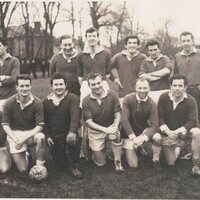 Staff Postgraduate Soccer Team, 1968
Staff Postgraduate Soccer Team, 1968 This picture shows the UCG Staff & Postgraduate Soccer Team of 1968. The match with the undergraduates took place on 14th Feb. 1968 during the first ever ‘College Week’. Names of Team members are given below from left to right:
Top row: Kieran Murphy; Tom O’Connor; Hubert McDermott, Stephen G. Jennings, Gearóid Ó Tuathaigh; Kieran Dunican
Bottom row: Pete Smith; Pat Fottrell; Michael Hynes; Dan O’Donovan; Sean Lavelle; Dermot Geaney
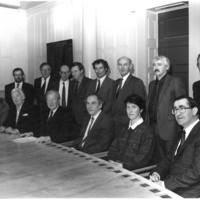 Inaugural meeting of the Discovery Programme Advisory Panel, 10 May 1991
Inaugural meeting of the Discovery Programme Advisory Panel, 10 May 1991 This official photograph was taken at the first meeting of the Advisory Panel assembled by Taoiseach Charles Haughey to define the objectives and initial work plan of the Discovery Programme.
Seen here, left to right:
Standing: Pat Wallace; Michael Herity; Anthony Cronin; John Waddell; Peter Woodman; Noel Lynch; Mike Baillie; unidentified representative of the OPW.
Seated: unidentified representative of the OPW; George Eogan; Michael Morris, Lord Killanin; Charles Haughey, Taoiseach; Aidan Clarke, President of the RIA; Anne Lynch, OPW; John Mahony, OPW.
Created at the initiative of the then Taoiseach, Charles J. Haughey, the Discovery Programme began its work in 1991. The stated aim of the body was ‘through archaeological and related research to work towards a coherent and comprehensive picture of human life on this island from earliest times’ (Discovery Programme, p. 6). Its initial focus was on the Late Bronze Age/Iron Age ‘or Celtic period’. This was an objective aligned to the major trends of Irish archaeology at the time and, incidentally, to Charles Haughey's own declared interests (Monk & Sheehan, p. 2).
Two of those appointed to this influential Advisory Panel had links to the University in Galway: Pat Wallace, a UCG graduate and later Director of the National Museum, and John Waddell, a UCG graduate and later Professor of Archaeology in NUIG.
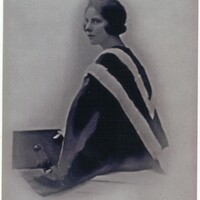 Mary J (Nina) Carlos Graduation in 1923
Mary J (Nina) Carlos Graduation in 1923 Mary Josephine (Nina) Carlos went to UCG in 1920 having obtained an Ordinary Entrance Scholarship to U.C.G. and she graduated in 1923 with a 1st Class Honours BA degree and a B.Comm degree in the same year, followed by a Higher Diploma in Education with Second Class Honours in 1924. She married Prof. Tom Dinan on 17th September 1942. Nina Carlos Dinan died on 2nd September 1984. Further details of her life are described (Patrick Larkin, Asset Id 13737).
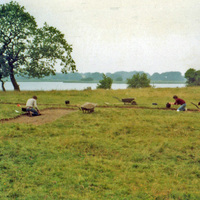 Ballaghkeeran Archaeological Dig, 1982
Ballaghkeeran Archaeological Dig, 1982 The picture shows archaeological fieldwork in progress in the townland of Ballaghkeeran Little, Barony of Kilkenny West, on the S.E. shores of Lough Ree, County Westmeath. Four persons are involved including one woman. The excavation fieldwork was under the direction of Dr. Tom Fanning, Department of Archaeology, University of Galway.
The Archaeological fieldwork included the excavation of a number of trial trenches at a fortified promontory on Lough Ree in the R. Shannon. The possibility that the site was a Viking-type longphort was borne in mind due to the mid 9th- and early l0th-century references to a Viking fortification on the Lough (T. Fanning, 1983, p.221).
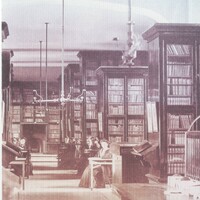 The Library at Queen's College Galway c. 1906
The Library at Queen's College Galway c. 1906 The Library extended along the first floor of the North side of the Quadrangle building and was over 150 feet in length. The Librarian, when a picture of the library was taken in about 1906, was Valentine Steinberger, Professor of Modern Languages (1886 – 1916).
James Hardiman (1782-1855), the noted historian and antiquarian, was appointed to the post of Librarian in 1849 by the first President of the University, Reverend Joseph W. Kirwan. Hardiman died in 1855 and was succeeded as Librarian in 1856 by John Richardson, who produced the first printed catalogue of the collections in 1864 – he resigned as Librarian in 1876 (www.library.universityofgalway.ie).
Richardson’s successor was D’Arcy Wentworth Thompson (Professor of Greek (1864 to 1902) who took over in 1877as Acting Librarian and he held the post up to his death in 1902 . Valentine Steinberger, Professor of Modern Languages (1886 – 1916), served as Librarian from 1902 until his death in 1916
Prof. John Howley, Professor of Philosophy was Librarian from 1917 up his retirement in 1936 (A. Keaveney 'Classics in Victorian Galway', 1999, p. 331).
The Library was then run by the Library Clerk, Michael Fahy, with Christy Townley as his Assistant, under the direction of the Library Committee, when the practice of appointing a Professor, as also Librarian, was discontinued from 1936. Upon Mr. Fahy’s retirement in 1960, Christy Townley was left on his own to manage the Library and he was appointed in 1966 as the first full-time and non-Professorial Librarian. He retired in 1982. The Library was moved from the Quadrangle to purpose-built accommodation in 1973, in the planning of which Christy played a central role (R. O’Neill 'Modern Languages', 1999, p.369).
Alf MacLochlainn was appointed Librarian in 1982 and he retired in 1987. Pat O' Connell was then appointed as Acting Librarian until 1991 when Marie Reddan was appointed as Librarian. She retired in 2008 and was succeeded by John Cox as Acting Librarian. John Cox was appointed Librarian in 2009 and he retired in 2023. He was succeeded by Monica Crump as Acting Librarian (University Calendars).
Michael Duignan (right) pictured with Frau Thurneysen and Rudolf Thurneysen, Bonn, c. 1937. Duignan had been appointed to help the eminent Celtic scholar with an English translation of his Handbuch des Alt-Irischen to be published in 1946 as A Grammar of Old Irish (edited by D.A. Binchy and O. Bergin).
Duignan was appointed Professor of Celtic Archaeology in University College Galway in 1944.
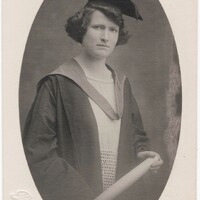 Carmel Hibbett Graduation, 1922
Carmel Hibbett Graduation, 1922 Carmel Hibbett graduated with a Commerce degree at University College Galway in Nov. 1922 (UCG Calendars).
Carmel Hibbett was a daughter of Thomas Bernard Hibbett and Elizabeth Lucy Rushe. Carmel was born in Kilconnell, Co. Galway on 2 Dec. 1899 (Killure-Kilgerrill, 2022). She was a student at University College Galway from 1919 to 1922. She obtained her Commerce degree in the autumn of 1922. She passed away on 23 Oct. 1989 in Dublin (www.irishgenealogy.ie).
 Quadrangle - seating erected for President Reagan honorary conferring
Quadrangle - seating erected for President Reagan honorary conferring In the Quadrangle , University of Galway, scaffolding, platform for TV cameras and raked seating for politicians, journalists and invited guests, in addition to the seats in the front rows, for the conferral by the NUI of the honorary degree of DLitt, and the bestowal by Galway Borough Council of the award of honorary freeman of Galway City, on US President Ronald Reagan on June 2, 1984 on the occasion of his visit to Ireland, coinciding with the celebration of the Quincentenary of the granting of a charter of incorporation to Galway City in 1484. The platform for the ceremonies was erected directly in front of the Aula Maxima in the west wing, and the photograph was taken to the left of that and facing the Archway, where two people and several noticeboards are visible.
The citation for the DLitt was given by Dr Colm Ó hEocha, President of UCG, in his capacity as a Pro-Vice-Chancellor of the NUI, and the degree was conferred by the Chancellor of the NUI, Dr T.K. Whitaker. The ceremony for the honorary freeman award was presided over by the then Mayor of Galway, Cllr Michael Leahy.
The award of the degree was quite controversial, in view of widespread concern in Ireland at US policy and actions in Central America, particularly Nicaragua. The ceremonies were boycotted by a number of academic staff - some of whom arranged a 'de-conferring' ceremony downtown at which some recipients of honorary degrees, including Peadar O'Donnell, burnt their NUI parchments in protest - and by Bishop Eamonn Casey and others. There was also a well-attended protest meeting in Fr Burke Park, Fr Griffin Road. The Quadrangle doors (except for the front door of the Aula Maxima, presumably for the benefit of the television coverage) were repainted white for the occasion, as a security measure at the insistence of the US Secret Service, according to one account. According to another account, the Buildings Office decided that the Quadrangle needed a freshening up for the visit, but, as the grainy traditional door finish was of a quality that would require specialist painters to do the work, an expertise which did not exist among the in-house painters, it was decided, given the time constraints and costs involved, to have the colour white applied by the in-house painters, on the basis that it was a good primer colour, and a good base for a different colour later (in the event, maroon). The tubular steel structures seen in this image and used in erecting the camera platforms and elevated seating had to be guarded overnight and inspected before proceeding the following day, lest someone had placed explosives in it! The Secret Service took command of the Quadrangle on the night before the ceremony, having previously inspected the whole building thoroughly and inspected all manholes in the Quadrangle and welded their covers for security reasons. On the morning of the ceremony, a couple of large vans, containing sniffer dogs and handlers, arrived at the Archway and proceeded to go through the area again to check for any obstacles and explosive substances. During the ceremony, uniformed Gardaí were stationed on the rooftops of the Quadrangle, along with Secret Service personnel distributed around the area.
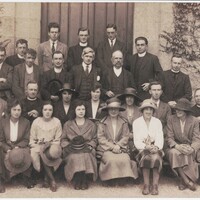 Higher Diploma in Education Class of 1923
Higher Diploma in Education Class of 1923 The picture shows the graduation class of the Higher Diploma in Education in 1923. It also includes some staff including Fr. Tomás Ó Ceallaigh, first Professor of Education at University College Galway.
Fr. Tomás Ó Ceallaigh was Professor of Education at the time of the graduation of the Higher Diploma in Education class of 1923. He is likely to be in the second row from the top, third from the left and holding a hat – this is reasonably consistent with the writing at back of the photographic postcard which reads ‘Father O’Kelly, the celebrated Professor and writer of Neo-Celtic Opera is to be seen in this photo in one of his characteristic moods (Daily Mail, Jul. 1923). Graduands included Patt Larkin, on the left in the top row; Rita Carlos (fifth from the left in bottom row) and Frances Moffett (sixth from the left in bottom row).
Tomás Ó Ceallaigh was born in Gurteen, Co. Sligo on 15 December 1879. At the age of thirteen he won first place in a scholarship examination to Summerhill College, Sligo. Later, in 1897, he went as a clerical student to Maynooth College, was ordained priest in 1903, and after the award of the Licentiate in Theology degree returned to Summerhill College where he taught until 1912.
In 1908, he obtained a Bachelor of Arts degree at the National University of Ireland, and from 1913 to 1914 studied in University College Dublin where he was awarded the Higher Diploma in Education
He was appointed as first Professor of Education at University College Galway in 1914. Ó Ceallaigh came to Galway with the reputation of a scholar, an outstanding, experienced teacher, and a writer, especially in Irish. He was awarded the M.A. Degree in University College Dublin in 1922.
He became very ill in 1923 and his doctor advised him to go to France. He left Galway on Feb. 4th 1924. Within three weeks, on 24 February, Ó Ceallaigh died in France, in San Roche Hospital, Nice and he was buried in Nice Cemetery. He was succeeded in the position of Chair of Education by Patt Larkin in 1925 (E. Ó Héideáin, History of Education, 1968-88), (www.universityofgalway.ie/ school-of-education).
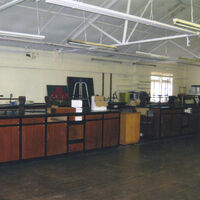 Science Teaching Centre, Education Department
Science Teaching Centre, Education Department The Science Teaching Centre of the Education Department in Block M, about 1994.
As recalled by Oliver Ryan, Lecturer in the Department, An tOllamh Eustás Ó Héideáin, Professor of Education, had made serious efforts since the early 1970s to improve the standard of training for the Science teacher in the West of Ireland, and in 1973 acquired a large pre-fabricated building (the old Chemistry laboratory*). At his request, Oliver drew up plans for a Science Teaching Centre, and, after a frantic search for funding, a small grant was obtained and in 1974 the Centre. As of 1982, the Centre provided facilities training for some 70 Science graduates enrolled in the Higher Diploma in Education programme, was host to an active branch of the Irish Science Teachers Association, and gave assistance to Science teachers in the Galway catchment area.
The Centre comprised a large laboratory, a workshop, a store room, a darkroom and three offices. The laboratory was designed to serve as a demonstration/lecture/practical laboratory, roughly divided into five main areas: physics, chemistry, biology, a lecture area, and a library/audiovisual area. The laboratory aimed to provide a model for student teachers on how best to store, organise and index the normal school laboratory. It was well endowed with audiovisual equipment such as slide projectors, overhead projectors, videorecording apparatus, micro-projectors etc, all of which were in constant demand and use. The workshop, which was intended for us in both the improvisation and repair of apparatus, contained a number of work-benches and a supply of both power and manual tools. The store was used principally for the storage of chemicals. This photograph shows the .....
* (Note: This former Chemistry laboratory presumably became available on its move to the new Arts/Science Building on its opening in 1973. )
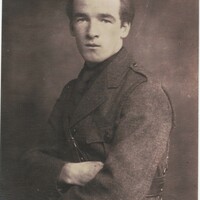 Jack Lohan, UCG Engineering student, 1919 and IRA Volunteer
Jack Lohan, UCG Engineering student, 1919 and IRA Volunteer John Joseph (Jack) Lohan was born on 19 March 1902 at Raven Terrace, Galway. In 1919 he was awarded a Galway County Council Scholarship to University College Galway, where he studied Engineering and Science. However he failed his examinations in 1920 and in the Summer of 1921 - he was absent for the Autumn Examinations. He was attached to the Galway City Company IRA and was shot dead by members of the Free State Army on 24 September 1922 (Coláiste na Ollsgoile Gaillimh - Tortha na Sgrúdú, 1918-23). His picture was taken in C J Leaper's photographic studio in Nun’s Island Galway. C.J. Leaper wrote a book entitled ‘Experimental Photography’, published in 1890.
Jack Lohan was the second child and eldest son, born on 19 March 1902 in Raven Terrace, Galway to parents Michael Lohan and Annie Gannon, both National School teachers. The family later lived in Woodquay, Galway. Following his primary education at Bohermore National school, where his father taught, he attended St. Mary’s College Galway. He obtained a Galway County Council Scholarship to University College Galway in 1919, where he studied Engineering. The Examination results for 1920 show that Jack failed in both 1st Engineering and in 1st Science. He also failed 1st Engineering in the summeer of 1921 and was absent for Autumn examinations.
Jack Lohan was attached to the Galway City Company IRA during the War of Independence (1919–21). He took the anti-treaty side in the ensuing Civil War. He was shot dead at McHugh’s public house on the Tuam road on 24 September 1922 (Connacht Tribune, issue of 30 Sep. 1922), (B. McGowan, Galway City Museum),
(https://galwaycitymuseum.ie_seaghan-o-lochain-1902-22). He was buried in the New Cemetery, Bohermore, Galway. His name ‘An Caiptín Seán Ó Lócáin’ is inscribed on the Republican monument off the Tuam road, Castlegar, Galway.
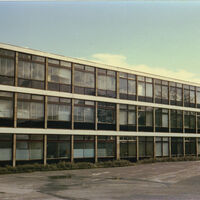 Áras de Brún, pre-1989
Áras de Brún, pre-1989 The west side of Áras de Brún, University of Galway. Named after the then recently retired President of the University, Monsignor Pádraig de Brún (1889-1960), designed by Michael Scott and opened on 18 May 1963, Áras de Brún was the first building erected on campus since the Old Arts Building in 1932. It provided badly needed lecture halls and offices for a variety of disciplines and services over the years, including Mathematical Sciences, Natural Sciences, Ancient Classics, History, English and Student Services. In later years it was also labelled as Block C in the campus zonal identification system.
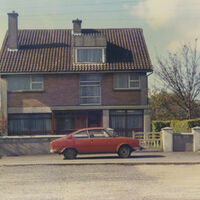 O'Toole house, 16 Distillery Road, Newcastle, Galway
O'Toole house, 16 Distillery Road, Newcastle, Galway The house, 16 Distillery Road, Newcastle on the then edge of the campus, acquired from the O'Toole family, was used as offices for a variety of areas. At this time on the ground floor were Joe Watson (Industrial Liaison Officer) and Kathleen Hartnett (Cumann Céimithe na Gaillimhe); on the first floor were an Engineering Faculty office at the rear occupied by Clare Walsh and Gearóid Barry (Marketing). The house was later demolished, and the Health Promotion Department now occupies that location, according to Google maps.
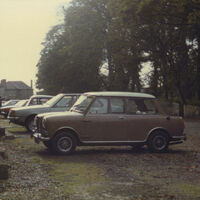 Carpark outside old Microbiology prefabs (on site of Martin Ryan Building)
Carpark outside old Microbiology prefabs (on site of Martin Ryan Building) This was a carpark , on a rough surface, outside the old Microbiology prefabs, on the road leading to the former Irish Metal Industries (IMI) factory where the Martin Ryan Building (now part of the Ryan Institute) was soon to be erected.. The view is towards the Canal, and part of the stairway into this prefab is visible at the left. The car nearest to us is a Wolseley Hornet.
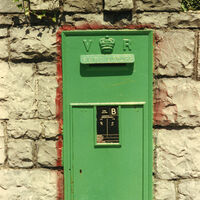 Victorian postbox, University Road, Galway
Victorian postbox, University Road, Galway This is a Victorian postbox from the period 1887-1901, set into the cut limestone southern boundary wall of the University on University Road, Galway. The first postboxes (pillar boxes) were introduced in the Channel Islands in 1852 for the Post Office by Anthony Trollope (the later novelist who had also worked in Ireland for the Post Office) for the convenience of people at a distance from a post office. They reached Ireland in 1855. Smaller postboxes set into a wall were introduced in 1857. A new design was introduced in 1887, incorporating the royal cypher - at that time the letters VR (= Victoria Regina) with the Royal Crown between them - on the door and the words ‘Post Office’ on the hood above the aperture for letters. From the royal insignia on this postbox, it can be dated to the period 1887-1901.
Most of the early postboxes were painted dark bronze green throughout the United Kingdom, but in 1874 the Post Office decided to make postboxes more conspicuous by painting them royal red. Following Independence, the Irish Post Office generally left the postboxes as they were, but had them painted in the national colour, green.
The black section on the door sets out the collection times for weekdays, weekends and bank holidays: see the transcription of the text below under 'Text in image'. In that context, the letter B probably stands for Bailiú (= Collection).
The wall in which it is set is the southern boundary wall of the University as reconstructed (and lowered to make the University more visible to the public) in 1965 as a consequence of Galway Corporation's road widening scheme in the area
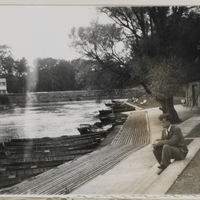 Outside the Men's Club, late 1940s
Outside the Men's Club, late 1940s This unidentified young man was very probably a friend of James Ward's mother, who was a medical undergraduate in the 1940s. The Men's Club was where students usually accessed the boats that they used to row up to Lough Corrib, or to train for rowing competitions.
This photo shows how the facility was laid out. The seats along the bank and the presence of over a dozen rowing boats are an indication of its popularity.
Recreational use of the boats at the Men's Club was an important feature of student social life, whether on group outings or in couples. At one time, if a woman student was invited 'to go for a row up the Corrib' it was considered to be a serious date.
By the 2020s the Rowing Club, or Boat Club, was one of the largest clubs in the University of Galway. Its women's and men's teams and individual competitors have been remarkably successful at national and international level. In 2022 the club took home 9 championship titles, making it the most successful club at the National Rowing Championships ('Rowing Club'). The present clubhouse with its gym and boat sheds is on the south side of the main campus, a 5-minute walk from its centre.
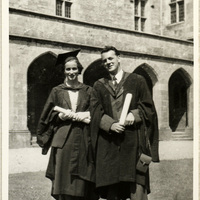 Two new medical graduates, 1950 or 1951
Two new medical graduates, 1950 or 1951 Portrait of Eileen O'Cleary and friend on the day they received their medical degrees.
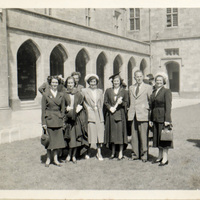 Medical graduates and friends at their conferring, 1950 or 1951
Medical graduates and friends at their conferring, 1950 or 1951 The young woman second from the left in the front is Eileen O'Cleary.
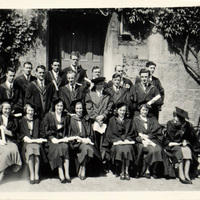 Medical graduates on Conferring Day, 1950 or 1951
Medical graduates on Conferring Day, 1950 or 1951 In this photograph, taken in the Quadrangle, the only person who has been identified is Eileen O'Cleary (front row, 4th from left). The older man in the centre of the photograph may be either the Dean of Medicine or the President of the University.